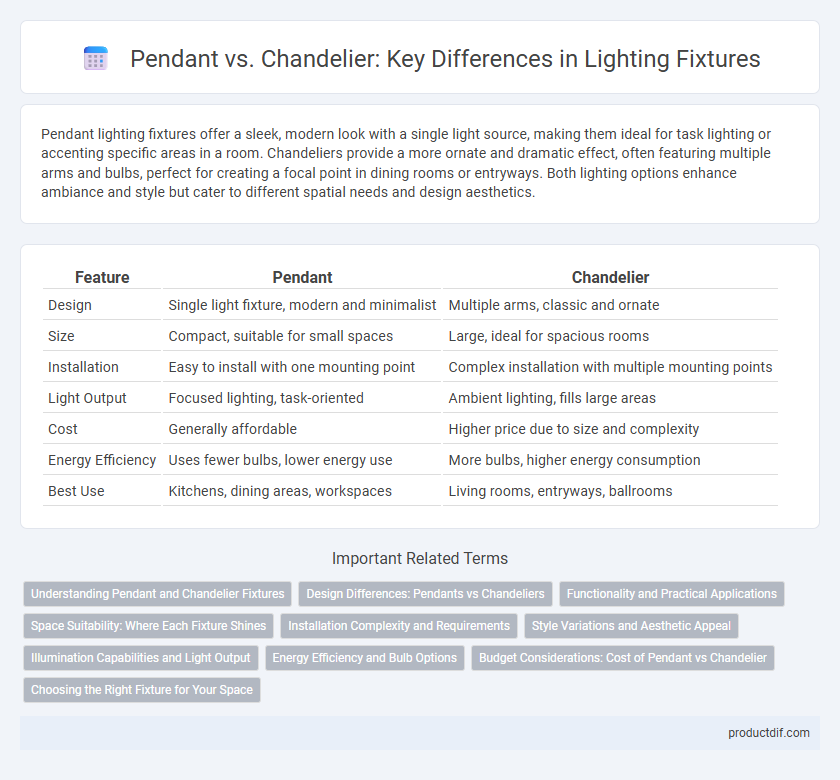Pendant lighting fixtures offer a sleek, modern look with a single light source, making them ideal for task lighting or accenting specific areas in a room. Chandeliers provide a more ornate and dramatic effect, often featuring multiple arms and bulbs, perfect for creating a focal point in dining rooms or entryways. Both lighting options enhance ambiance and style but cater to different spatial needs and design aesthetics.
Table of Comparison
| Feature | Pendant | Chandelier |
|---|---|---|
| Design | Single light fixture, modern and minimalist | Multiple arms, classic and ornate |
| Size | Compact, suitable for small spaces | Large, ideal for spacious rooms |
| Installation | Easy to install with one mounting point | Complex installation with multiple mounting points |
| Light Output | Focused lighting, task-oriented | Ambient lighting, fills large areas |
| Cost | Generally affordable | Higher price due to size and complexity |
| Energy Efficiency | Uses fewer bulbs, lower energy use | More bulbs, higher energy consumption |
| Best Use | Kitchens, dining areas, workspaces | Living rooms, entryways, ballrooms |
Understanding Pendant and Chandelier Fixtures
Pendant fixtures feature a single light source suspended from the ceiling, offering focused illumination and sleek design ideal for task lighting or accenting specific areas. Chandeliers consist of multiple light arms branching from a central point, providing ambient light and making a bold decorative statement often suited for larger spaces like dining rooms or foyers. Understanding the differences in size, light output, and aesthetic impact helps in selecting between pendant and chandelier fixtures for functional and stylistic needs.
Design Differences: Pendants vs Chandeliers
Pendant lighting features a single light source suspended from the ceiling, often designed with minimalistic or industrial aesthetics, ideal for focused task lighting or accentuating specific areas. Chandeliers typically consist of multiple arms and light bulbs, offering a grand, intricate design that serves as a focal point in larger rooms or formal settings. The main design difference lies in pendants' simplicity and versatility compared to chandeliers' elaborate and decorative structure, influencing both ambiance and spatial impact.
Functionality and Practical Applications
Pendant lighting offers targeted illumination ideal for task-oriented spaces such as kitchen islands or reading nooks, providing focused light with adjustable height options. Chandeliers deliver ambient, decorative lighting that enhances dining rooms or entryways with multi-directional light and a striking visual centerpiece. Both fixtures balance aesthetics and functionality, but pendants emphasize practicality and versatility, while chandeliers prioritize grandeur and atmospheric ambiance.
Space Suitability: Where Each Fixture Shines
Pendant lights excel in small to medium-sized spaces, offering focused illumination and modern aesthetics perfect for kitchens, dining areas, and hallways. Chandeliers are ideal for larger rooms with high ceilings like grand foyers, dining rooms, and ballrooms, providing opulent ambient lighting and dramatic visual impact. Selecting between a pendant and a chandelier depends on ceiling height, room size, and the desired lighting effect to maximize spatial harmony and functionality.
Installation Complexity and Requirements
Pendant lighting fixtures typically feature a single light source suspended from the ceiling, making their installation more straightforward and requiring minimal electrical work, suitable for standard ceiling boxes. Chandeliers, often larger and heavier with multiple arms, demand reinforced ceiling mounts, additional electrical wiring, and careful weight distribution to ensure safety and stability. The complexity of installing a chandelier generally involves professional expertise, especially in handling higher voltage connections and securing heavy fixtures.
Style Variations and Aesthetic Appeal
Pendant lights offer sleek, minimalist designs ideal for modern or industrial interiors, featuring single or clustered bulbs that create focused illumination with a subtle aesthetic appeal. Chandeliers provide ornate, multi-branched structures often embellished with crystals or intricate metalwork, making them a statement centerpiece in traditional, luxury, or classic decors. The choice between pendant and chandelier lighting fixtures significantly influences the room's ambiance, balancing functionality with decorative elegance tailored to specific interior styles.
Illumination Capabilities and Light Output
Pendant lighting fixtures typically provide focused illumination suitable for task lighting and accentuating specific areas, offering adjustable brightness levels depending on the bulb and shade design. Chandeliers deliver a broader light output, often featuring multiple bulbs arranged in a decorative frame, which enhances ambient lighting and creates an even distribution of light across larger spaces. The choice between pendant and chandelier hinges on the desired light intensity and coverage, with pendants excelling in directed lighting and chandeliers providing widespread illumination.
Energy Efficiency and Bulb Options
Pendant lights typically use fewer bulbs than chandeliers, resulting in lower overall energy consumption and increased energy efficiency for smaller spaces. Pendant fixtures often accommodate LED bulbs, which provide long-lasting, energy-saving illumination, while chandeliers, with multiple arms, support a wider variety of bulb types including incandescent, halogen, and LED options. Choosing LED bulbs in either pendant or chandelier fixtures maximizes energy savings and reduces electricity costs without compromising light quality or style.
Budget Considerations: Cost of Pendant vs Chandelier
Pendant lighting typically offers a more affordable option compared to chandeliers, with prices starting as low as $50 for basic models. Chandeliers often involve higher costs due to intricate designs and multiple light sources, with prices generally beginning around $200 and reaching several thousand dollars for luxury pieces. Budget considerations should also include installation expenses, as chandeliers usually require professional installation, increasing overall costs.
Choosing the Right Fixture for Your Space
Pendant lights offer versatile, focused illumination ideal for kitchens, dining areas, or small spaces, while chandeliers provide dramatic, ambient lighting perfect for large rooms or formal settings. Consider ceiling height, room size, and decor style to ensure the fixture complements the space without overwhelming it. Selecting the right fixture enhances both functionality and aesthetic appeal, balancing light distribution and visual impact.
Pendant vs Chandelier Infographic

 productdif.com
productdif.com